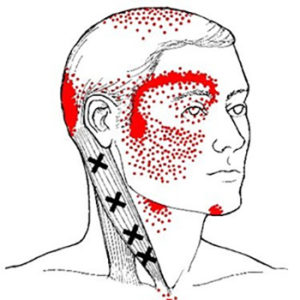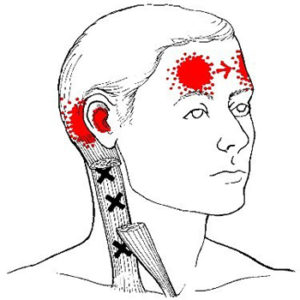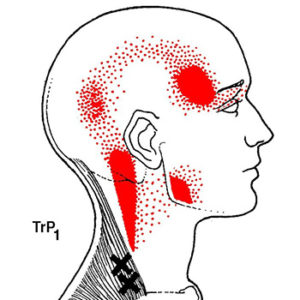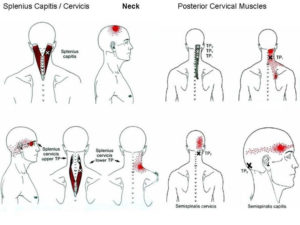
Headaches are often triggered and/or aggravated by a constellation of muscles of the neck that contain taut bands, trigger points and other dysfunctional segments. Understanding the relationships between these muscles helps determine approaches for treatment and as well as self-care.
The muscles of the neck are part of a myofascial system that includes not only an anatomical but also a functional continuum. This means that a dysfunction of one muscular portion will result in a functional alteration of all the muscles of the neck. This must be taken into account for a successful resolution of the problem.
Major Muscle Groups
There are three groups of muscles that cause much of this pain directly. In addition, these muscles tend to cause satellite trigger points and dysfunctional patterns in other muscles of the head, neck, shoulder and arm.
 Sternocleidomastoid – The two different branches of the SCM, the “sternal” (pictured above) and the “clavicular” provide direct referral patterns that cover large areas of the face and head. Dysfunction in the SCM can cause headaches, facial pain and autonomic responses such as changes to the function or perception of the eyes and ears. This includes tearing, fluttering of the eyelids, unilateral deafness, tinnitus and vertigo.
Sternocleidomastoid – The two different branches of the SCM, the “sternal” (pictured above) and the “clavicular” provide direct referral patterns that cover large areas of the face and head. Dysfunction in the SCM can cause headaches, facial pain and autonomic responses such as changes to the function or perception of the eyes and ears. This includes tearing, fluttering of the eyelids, unilateral deafness, tinnitus and vertigo.
Even worse, the SCM tends to induce satellite disturbances in other muscles within its referral zone. An unhappy SCM can cause a cascade of problems.
 The trapezius. Pain patterns of the upper trap include the temples and the side/back of the neck. The similarities to aspects of the SCM pattern are no accident. In embryological development, the trapezius and sternocleidomastoid muscle form separately from most other muscles as a singular mass. The two muscles split around the 20th week but retain common nerve connections.
The trapezius. Pain patterns of the upper trap include the temples and the side/back of the neck. The similarities to aspects of the SCM pattern are no accident. In embryological development, the trapezius and sternocleidomastoid muscle form separately from most other muscles as a singular mass. The two muscles split around the 20th week but retain common nerve connections.
The trapezius is actually divided into upper, middle and lower sections and taut bands and trigger points in the lower sections can refer to the neck and interfere with treating the upper trap. The trapezius can, in turn, induce satellite trigger points and dysfunctional areas in muscles such the SCM and posterior neck group.
 Posterior Neck Muscles. Distribution of pain patterns include the top/back of the head, the temples and back of the neck. In fact, if you overlay the pain patterns of the posterior neck muscles with the SCM and trapezius there are quite a lot of areas in common.
Posterior Neck Muscles. Distribution of pain patterns include the top/back of the head, the temples and back of the neck. In fact, if you overlay the pain patterns of the posterior neck muscles with the SCM and trapezius there are quite a lot of areas in common.
The cervical spinal erectors, semispinalis cervicis and capitis, work in concert with splenius cervicis and capitis group and others, to provide postural support, rotation, side flexion and extension of the neck. Other muscles in the referral zone of these muscles include the SCM and trapezius, so it is easy to see how the can all participate in a cycle of dysfunction.
Satellite Trigger Points and Dysfunction
Major satellites of the SCM include the masseter and temporalis (used in chewing), the trapezius and posterior cervical muscles and smaller muscles of the front of the neck, such as the scalenes (respiratory muscles) and the infrahyoids and suprahyoids (used in swallowing and speech). Some of these, in turn can cause issues in the shoulder and arm.
Common satellites of the trapezius include different segments within itself, such as the lower trap inducing dysfunction in the upper trap, levator scapulae and muscles of the shoulder. The larger posterior neck muscles may cause tight bands and trigger points to develop in the small cervical multifidi and sub-occipital muscles,
Treatment Approaches
An individual has headaches behind the eyes and at the temples on both sides and pain in the back of the neck on the right side. They can rotate the head/neck pretty well and there is no popping or pain with opening the jaw or chewing. During postural evaluation we have noted consistent forward flexion of the neck. It also came up that there is an A/C vent pretty much directly over the individual at work.
We start considering the SCM, lower and upper trapezius, semispinalis capitis and upper portion of splenius cervicis on both sides to address the pain at the temples. For the neck pain on the right, we would treat the 2nd (lower) trigger points of splenius cervicis and the upper trap and in the multifidi of the neck on the right side. I would probably treat these muscles in approximately reverse order, ending with the SCM.
The goal is to release trigger points and taut bands so that muscles that are locked short can lengthen, and those that are locked long can shorten and regain their normal tone. We would typically perform trigger point compression and myofascial release and movement through the entire range of motion of these muscles.
Self care would focus on gentle stretching and disengagement of the SCM and strengthening of the lower traps and deep cervical flexors in the front of the neck. This will allow the upper traps and posterior cervical muscles to return to normal length and tone. Finally, we’re suggesting moving the desk or diverting the vent that is blowing on the back of the neck; this is known to cause trouble with some neck muscles.
Self Care Strategies
Neck issues can be complicated, with a significant number of muscles involved. Focus on key elements that directly impact the primary issues you are facing. Self-compression is the foundation of myofascial self-care. However, in dealing with the neck, it is important to respect the delicacy of the area. Be gentle with yourself!
Do not use ice on your neck! For most other areas of the body, ice can be used safely and effectively to reduce inflammation. However, because cold can activate known trigger points in certain neck muscles, we avoid ice in this area.
Limit stretches to the appropriate areas. Not every “tight” muscle benefits from stretching. For instance, prolonged flexion of the neck makes posterior neck muscles feel tight from being over-stretched. Further stretching will not help. These muscles are “locked long” and need to be reset to their normal length through compression, muscle activation and restoring range of motion on the shorter end. Gentle stretching of the front of the neck, including the SCM, will be more effective than stretching the back of the neck, no matter how “tight” it might be.
If you are having similar issues, you may find that a session or two to identify and treat root causes of your individual case is helpful. Call us at 630-858-0000 today to make an appointment!
